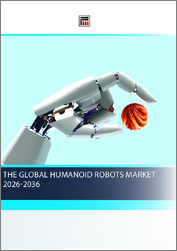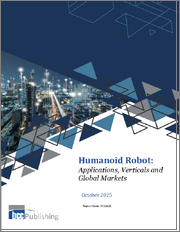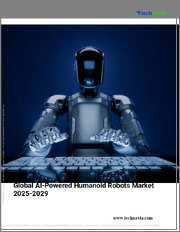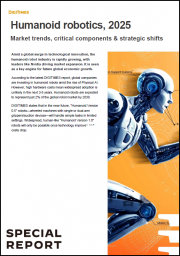
|
시장보고서
상품코드
1854889
세계의 휴머노이드 로봇 시장(2026-2036년)The Global Humanoid Robots Market 2026-2036 |
||||||
2025년, 휴머노이드 로봇 시장은 그 어느 때보다 빠른 속도로 성장하고 있으며, 그 활동은 당초 예측을 훨씬 뛰어넘어 가속화되고 있습니다. 투자, 생산 규모 확대, 상업적 전개가 수렴하고 있으며, 이는 이 산업이 조사 프로토타입에서 상업적 현실로 결정적으로 전환되었음을 보여줍니다. 중국 로봇 산업에서 자금 조달 활동이 두드러지고 있으며, 2025년 1-9월 기간에는 610건, 총 500억 위안(70억 달러)의 투자 거래가 발생하여 전년 동기 대비 250% 증가하였습니다. 3분기에만 243건의 거래가 발생해 전년 동기 대비 102% 증가했습니다. 주요 거래로는 베이징에 본사를 둔 Noetix Robotics가 3억 위안(4,200만 달러)의 Pre-B 자금 조달을 완료한 것, 업계 선두주자인 UBTECH가 배치, 전환사채, 현금 인출권을 포함한 10억 달러의 대규모 전략적 자금 조달을 확보한 것 등이 있습니다. 이러한 자본 유입은 상업화 일정이 예상보다 빨라지고 있다는 투자자들의 자신감을 반영하고 있습니다.
모든 주요 지역에서 생산능력이 크게 확대되고 있습니다. 테슬라는 2025년까지 옵티머스 5,000 대 생산을 목표로 삼고 있으며, 2026년까지 10만 대로 확대할 계획입니다. 중국 제조사 BYD는 2025년까지 휴머노이드 1,500 대 생산을 목표로 삼고 있으며, 2026년까지 2만 대로 확대할 계획입니다. 상하이에 본사를 둔 Agibot 역시 2025년까지 5,000 대를 목표로 하고 있습니다. Agility Robotics는 연간 1만 대의 Digit 로봇을 생산할 수 있는 전용 공장을 건설했습니다. 이러한 생산에 대한 약속은 파일럿 규모의 제조에서 산업 규모의 운영으로의 근본적인 전환을 의미합니다.
가장 중요한 것은 비용의 벽이 예상보다 빠른 속도로 무너지고 있다는 점입니다. 중국 제조업체 Unitree는 2025년 7월, 자사의 휴머노이드 R1을 단돈 5,900달러에 출시하며 시장에 충격을 안겼습니다. 이는 자사의 G1 모델의 16,000달러, H1의 9만 달러에 이은 것으로, 시장의 Tier가 여러 개임을 알 수 있습니다. Goldman Sachs는 제조 비용이 전년 대비 40% 감소했다고 보고했으며, 현재 비용은 구성에 따라 3만 달러에서 15만 달러 사이라고 밝혔습니다.
파일럿 프로그램은 상업적 운영으로 전환되고 있습니다. Figure AI는 BMW의 슈페르탄베르크 공장에서 자동차 조립 테스트를 계속하고 있습니다. Agility Robotics의 Digit은 아마존과 GXO의 물류 시설에서 운영되고 있습니다. UBTECH는 BYD, Geely, FAW-Volkswagen, BAIC, Foxconn 등 주요 자동차 제조업체와 파트너십을 맺고 있습니다. 가장 주목할 만한 것은 Unitree의 휴머노이드 2대가 JD.com을 통해 소비자에게 판매된 것으로, 이 부문에서 처음으로 소비자 판매가 기록되었다는 점입니다. 10억 달러 규모의 자금 조달, 10억 달러 규모의 자금 조달10만생산량 목표, 1만 달러 이하의 가격 책정, 확대되는 상업적 출시의 수렴은 휴머노이드 로봇 시장이 중요한 변곡점에 도달했음을 시사하며, 당초 예상했던 2030년대가 아닌 2026-2028년 사이로 주류 채택이 가속화되고 있음을 시사하고 있습니다.
이 보고서는 세계 휴머노이드 로봇 시장을 조사하여 상세한 시장 예측, 경쟁 분석, 기술 평가, 지역별 시장 역학(보수적 시나리오와 낙관적 시나리오 포함) 등을 제공합니다.
목차
제1장 주요 요약
- 상업적 타당성
- 지역 생태계의 역학
- 현재 적용 및 개발 타임라인
- 투자 모멘텀과 시장 전망
- 시장 촉진요인과 과제
- 리더십에 미치는 전략적 영향
- 기술 준비도 및 향후 전망
제2장 소개
- 휴머노이드 로봇 : 정의와 특징
- 연혁과 진화
- 휴머노이드 로봇의 현황(2025년)
- 휴머노이드 로봇의 중요성
- 시장 및 용도(TRL)
- 세 가지 물결의 틀
- 상업적 개발 모델 및 단계
- 투자 및 자금 조달
- 비용
- 시장 촉진요인
- 과제
- 세계 규제
- 일본 시장
- 미국 시장
- 중국 시장
제3장 기술 및 구성요소 분석
- 휴머노이드 로봇 설계의 발전
- 주요 구성요소
- 지능형 제어 시스템 및 최적화
- 첨단 로봇 공학 및 자동화
- 제조
- 브레인 컴퓨터 인터페이스
- 로보틱스와 인텔리전트 헬스
- 마이크로나노로봇
- 의료·재활 로봇
- 메카트로닉스와 로봇공학
- 영상처리,로봇공학,지능형 비전,지능형 비전
- AI와 머신러닝
- 센서 및 인식 기술
- 전력 및 에너지 관리
- 액추에이터
- 모터
- 감속기
- 나사
- 베어링
- 암 이펙터
- 휴머노이드 로봇용 SoC
- 클라우드 로보틱스와 로봇 인터넷(IoRT)
- 인간-로봇 상호작용(HRI)과 소셜 로보틱스
- 생체 모방 디자인과 생체에서 영감을 받은 디자인
- 휴머노이드 로봇용 소재
- 피부 조직 결합
제4장 최종 용도 시장
- 시장 공급망
- 상업화 수준
- 의료·지원
- 교육·연구
- 고객 서비스·호스피탈리티
- 엔터테인먼트 및 레저
- 제조·산업
- 군·방위
- 개인 사용 및 가정 환경
제5장 세계 시장 규모(수량 및 수익)(2024-2036년)
- 시장 촉진요인과 노동력 역학
- 총 출하량 예측 : 세 가지 웨이브의 채택 모델
- 교체 주기의 역학
- 성장 궤적 분석
- 지역 분포 예측
- 시장 집중의 진화
- 이전 예측과의 비교
- 위험요인과 민감도
- 수익(합계)
- 평균 판매가격의 궤적과 촉진요인
- 지리적 수익 분포
- 교환 주기 수익의 역학
- 시장 구조와 집중도
- 배터리 용량(GWh) 예측
- 하드웨어 구성요소
제6장 기업 프로파일(95개 기업 프로파일)
제7장 학계가 개발한 휴머노이드 로봇
제8장 조사 방법
제9장 참고 문헌
KSM 25.11.13The humanoid robotics market is experiencing unprecedented momentum in 2025, with activity accelerating far beyond initial projections. Investment, production scaling, and commercial deployments are converging to signal that the industry has moved decisively from research prototypes to commercial reality. China's robotics sector has seen remarkable financing activity, with 610 investment deals totaling 50 billion yuan ($7 billion) in the first nine months of 2025-representing a 250% increase year-over-year. The third quarter alone witnessed 243 deals, up 102% from the prior year. Major transactions include Beijing-based Noetix Robotics completing 300 million yuan ($42 million) in Pre-B financing, while industry leader UBTECH secured a massive $1 billion strategic financing facility encompassing placements, convertible bonds, and cash-draw rights. This capital influx reflects growing investor confidence that commercialization timelines are accelerating faster than anticipated.
Production capacity is expanding dramatically across all major regions. Tesla is targeting 5,000 Optimus units in 2025 with plans to scale to 100,000 by 2026. Chinese manufacturer BYD aims for 1,500 humanoids in 2025, ramping to 20,000 by 2026. Shanghai-based Agibot similarly targets 5,000 units in 2025. Agility Robotics has constructed a dedicated factory capable of producing 10,000 Digit robots annually. These production commitments represent a fundamental shift from pilot-scale manufacturing to industrial-scale operations.
Perhaps most significantly, cost barriers are collapsing faster than projected. Chinese manufacturer Unitree shocked the market in July 2025 by launching its R1 humanoid at just $5,900-a price point previously thought impossible for years. This follows the company's G1 model at $16,000 and H1 at $90,000, demonstrating multiple market tiers. Goldman Sachs reported that manufacturing costs declined 40% year-over-year versus earlier projections of 15-20% annually, with current costs ranging from $30,000-$150,000 depending on configuration.
Pilot programs are transitioning to commercial operations. Figure AI continues testing at BMW's Spartanburg plant for automotive assembly. Agility Robotics' Digit operates in Amazon and GXO logistics facilities. UBTECH has secured partnerships with major automotive manufacturers including BYD, Geely, FAW-Volkswagen, BAIC, and Foxconn. Most notably, two Unitree humanoids were sold to consumers via JD.com, marking the first documented consumer sales in the sector. The convergence of billion-dollar financing, 100,000-unit production targets, sub-$10,000 pricing, and expanding commercial deployments suggests the humanoid robotics market has reached a critical inflection point, with mainstream adoption accelerating toward the 2026-2028 timeframe rather than the 2030s as originally forecast.
"The Global Humanoid Robots Market 2026-2036" represents the most comprehensive analysis of the rapidly evolving humanoid robotics industry, delivering strategic insights into a transformative technology sector poised to revolutionize manufacturing, healthcare, logistics, and consumer applications worldwide. This 400+ page market intelligence report provides detailed forecasts, competitive analysis, technology assessments, and regional market dynamics across conservative and optimistic scenarios.
This authoritative market research encompasses critical analysis of bipedal and wheeled humanoid robot technologies, examining deployment across six major end-use markets including healthcare and assistance, education and research, customer service and hospitality, entertainment and leisure, manufacturing and industry, and personal use and domestic applications. The report delivers granular market segmentation by geography (North America, Europe, Asia-Pacific, and Rest of World), comprehensive component cost analysis, technology readiness levels (TRL), and detailed profiles of 60+ leading humanoid robot platforms from established manufacturers and innovative startups driving the industry forward. Investment professionals, technology strategists, manufacturing executives, and R&D leaders will find unparalleled value in the report's dual-scenario forecasting methodology, extensive supply chain analysis, and detailed examination of artificial intelligence integration, sensor technologies, actuator systems, and advanced materials transforming humanoid robot capabilities. The research provides actionable intelligence on commercial viability timelines, ROI analysis, cost evolution projections, regulatory landscapes across major markets (Japan, United States, China), and strategic recommendations for stakeholders seeking to capitalize on the humanoid robotics revolution reshaping global labor markets and industrial automation.
Report contents include:
- Commercial viability and technology readiness assessment
- Regional ecosystem dynamics (China, North America, Europe)
- Current applications and deployment timelines
- Investment momentum and market forecasts
- Market drivers and challenges
- Strategic implications for industry leadership
- Humanoid robot definitions and characteristics
- Historical overview and evolution
- Current state of humanoid robots in 2025
- Market importance and applications by Technology Readiness Level (TRL)
- Models and stage of commercial development
- Investments and funding landscape
- Comprehensive cost analysis including current pricing, target pricing (2026-2030), cost breakdown by humanoid type, component cost analysis (actuators, structural components, power systems, computing, sensors, end effectors, software/AI, integration), cost evolution projections to 2036, cost per labor hour analysis, ROI timeline analysis, production volume impact on costs, regional cost variations, barriers to cost reduction, and cost competitiveness analysis
- Market drivers (AI advancements, labor force shortages and substitution, personal assistance needs, hazardous environment exploration)
- Commercial and technical challenges
- Global regulations
- Key market analysis for Japan, United States, and China
- Technology and Component Analysis
- Advancements in humanoid robot design
- Critical components overview
- Intelligent control systems and optimization
- Advanced robotics and automation
- Manufacturing processes (design, prototyping, component manufacturing, assembly, software integration, quality assurance, challenges in actuators, reducers, thermal management, batteries, cooling, sensors)
- Brain computer interfaces
- Robotics and intelligent health applications
- Micro-nano robots
- Medical and rehabilitation robots
- Mechatronics and robotics
- Image processing, robotics and intelligent vision
- Artificial intelligence and machine learning (AI hardware/software, functions, simulation, motion planning, foundation models, synthetic data generation, multi-contact planning, end-to-end AI, multi-modal algorithms)
- Sensors and perception technologies (vision systems, hybrid LiDAR-camera approaches, cameras and LiDAR variants, tactile and force sensors, auditory sensors, IMUs, proximity and range sensors, environmental sensors, GPS and localization)
- Actuators and drive systems (electric motors, hydraulic systems, pneumatic systems, hybrid systems, quasi-direct drive systems, series elastic actuators)
- Power and energy systems (battery technologies, battery management, charging infrastructure, energy harvesting, thermal management)
- Computing and control platforms
- Materials and manufacturing (metals, composites, polymers, elastomers, smart materials, textiles, ceramics, biomaterials, nanomaterials, coatings)
- Market Applications by End-Use Sector
- Healthcare and assistance (market drivers, applications, TRL assessment)
- Education and research (market drivers, applications, TRL assessment)
- Customer service and hospitality (market drivers, applications, TRL assessment)
- Entertainment and leisure (market drivers, applications, TRL assessment)
- Manufacturing and industry (market drivers, applications, automotive sector analysis, logistics and warehousing applications, implementation timelines)
- Military and defense (market drivers, applications, TRL assessment)
- Personal use and domestic settings (market drivers, applications, TRL assessment)
- Market Forecasts (2024-2036)
- Global humanoid robot shipments in units (conservative and optimistic estimates)
- Shipments by robot type: bipedal vs. wheeled (conservative and optimistic estimates)
- Shipments by region: North America, Europe, Asia-Pacific, Rest of World (conservative and optimistic estimates)
- Global revenues in USD (conservative and optimistic estimates)
- Revenues by end-use market (healthcare, education, customer service, entertainment, manufacturing, personal use)
- Automotive industry revenues and forecasts with deployment distribution
- Logistics and warehousing market forecasts
- Battery capacity forecasts for humanoid robots by industry segment
- Humanoid robot hardware component volume and market size forecasts
- Component market share and average costs per robot
- Company Profiles: Detailed profiles of leading humanoid robot manufacturers and technology developers, including product specifications, development status, target applications, funding information, partnerships, and market strategies. Companies Profiled include: 1X Technologies, AeiRobot, Aeolus Robotics, Agibot, Agility Robotics, AmbiRobotics, Andromeda, Apptronik, Axibo, Baidu, Beyond Imagination, Boardwalk Robotics, Booster Robotics, Boston Dynamics, BridgeDP Robotics, BXI Robotics, Clone Robotics, Dataa Robotics, Deep Robotics, Devanthro, Diligent Robotics, Dreame Technology, Electron Robots, Elephant Robotics, Embodied Inc., Enchanted Tools, Engineered Arts, EX Robots, FDROBOT, Figure AI, Foundation, Fourier Intelligence, Furhat Robotics, Galbot, Generation Robots, Hanson Robotics, Holiday Robotics, Honda, Humanoid, Kawada Robotics, Kawasaki Heavy Industries, Keenon Robotics, Kepler, K-Scale Labs, Leju Robotics, LimX Dynamics, Macco Robotics, MagicLab, Mentee Robotics, Mimic, Neura Robotics GmbH, Noetix, NVIDIA, Oversonic, PAL Robotics, PaXini Technology, Perceptyne, Persona AI, Proception, Pudu Robotics, Rainbow Robotics and more.....
TABLE OF CONTENTS
1. EXECUTIVE SUMMARY
- 1.1. Commercial Viability
- 1.2. Regional Ecosystem Dynamics
- 1.2.1. China: Speed, Scale, and State Direction
- 1.2.1.1. Company Concentration
- 1.2.1.2. Supply Chain Completeness - The Decisive Advantage
- 1.2.1.3. Computing Platforms
- 1.2.1.4. Government Policy
- 1.2.1.5. Market Scale Advantage
- 1.2.1.6. Strategic Outlook
- 1.2.1.7. Computing Platform Competition - Nvidia vs Chinese Alternatives
- 1.2.2. North America: Vertical Integration and Proprietary Stacks
- 1.2.3. Europe: The Trusted Humanoid Corridor
- 1.2.1. China: Speed, Scale, and State Direction
- 1.3. Current Applications and Deployment Timeline
- 1.4. Investment Momentum and Market Forecats
- 1.4.1. Phase 1: Dexterous Hands - The Current Imperative (2025-2027)
- 1.4.2. Phase 2: Cost Reduction - The Volume Enabler (2026-2030)
- 1.4.3. Phase 3: Safety & Regulatory - The Medical Gateway (2028-2035)
- 1.5. Market Drivers and Challenges
- 1.6. Strategic Implications for Leadership
- 1.7. Technology Readiness and Future Outlook
2. INTRODUCTION
- 2.1. Humanoid Robots: Definition and Characteristics
- 2.2. Historical Overview and Evolution
- 2.3. Current State of Humanoid Robots in 2025
- 2.4. The Importance of Humanoid Robots
- 2.5. Markets and Applications (TRL)
- 2.6. Three-Wave Framework
- 2.6.1. Wave 1: Industrial Applications (NOW - 2025-2030)
- 2.6.2. Wave 2: Consumer/Developer Applications (NEXT - 2027-2033)
- 2.6.3. Wave 3: Medical/Elder Care Applications (LATER - 2030-2036+)
- 2.6.4. Strategic Implications for Manufacturers
- 2.7. Models and Stage of Commercial Development
- 2.8. Investments and Funding
- 2.8.1. The Funding-Execution Paradox
- 2.8.1.1. Capital Efficiency Analysis
- 2.8.1. The Funding-Execution Paradox
- 2.9. Costs
- 2.9.1. Current market pricing (2025)
- 2.9.2. Target pricing (2026-2030)
- 2.9.3. Cost breakdown by Humanoid Type (Updated 2025)
- 2.9.4. Component cost analysis
- 2.9.4.1. Actuators and Motors
- 2.9.4.2. Structural Components
- 2.9.4.3. Power Systems
- 2.9.4.4. Computing and Control Systems
- 2.9.4.5. Sensors and Perception
- 2.9.4.6. End Effectors/Hands
- 2.9.4.7. Software and AI
- 2.9.4.8. Integration and Assembly
- 2.9.5. Cost evolution projections to 2036
- 2.9.6. Cost per labour hour analysis
- 2.9.7. ROI Timeline Analysis
- 2.9.8. Production volume impact on costs (2025-2036)
- 2.9.8.1. Regional cost variations (2025-2036)
- 2.9.9. Barriers to cost reduction
- 2.9.10. Cost competitiveness analysis (2025-2036)
- 2.10. Market Drivers
- 2.10.1. Advancements in Artificial Intelligence (AI) and Machine Learning (ML)
- 2.10.2. Labour force shortages
- 2.10.3. Labour force substitution
- 2.10.4. Need for Personal Assistance and Companionship
- 2.10.5. Exploration of Hazardous and Extreme Environments
- 2.11. Challenges
- 2.11.1. Commercial Challenges
- 2.11.2. Technical Challenges
- 2.12. Global regulations
- 2.13. Market in Japan
- 2.14. Market in United States
- 2.15. Market in China
3. TECHNOLOGY AND COMPONENT ANALYSIS
- 3.1. Advancements in Humanoid Robot Design
- 3.2. Critical Components
- 3.3. Intelligent Control Systems and Optimization
- 3.4. Advanced Robotics and Automation
- 3.5. Manufacturing
- 3.5.1. Design and Prototyping
- 3.5.2. Component Manufacturing
- 3.5.3. Assembly and Integration
- 3.5.4. Software Integration and Testing
- 3.5.5. Quality Assurance and Performance Validation
- 3.5.6. Challenges
- 3.5.6.1. Actuators
- 3.5.6.2. Reducers
- 3.5.6.3. Thermal management
- 3.5.6.4. Batteries
- 3.5.6.5. Cooling
- 3.5.6.6. Sensors
- 3.6. Brain Computer Interfaces
- 3.7. Robotics and Intelligent Health
- 3.7.1. Robotic Surgery and Minimally Invasive Procedures
- 3.7.2. Rehabilitation and Assistive Robotics
- 3.7.3. Caregiving and Assistive Robots
- 3.7.4. Intelligent Health Monitoring and Diagnostics
- 3.7.5. Telemedicine and Remote Health Management
- 3.7.6. Robotics in Mental Health
- 3.8. Micro-nano Robots
- 3.9. Medical and Rehabilitation Robots
- 3.10. Mechatronics and Robotics
- 3.11. Image Processing, Robotics and Intelligent Vision
- 3.11.1. Neural Processing Revolution
- 3.11.2. Spatial Understanding and Navigation
- 3.11.3. Human-Centered Vision Systems
- 3.11.4. Learning and Adaptation
- 3.12. Artificial Intelligence and Machine Learning
- 3.12.1. Overview
- 3.12.2. AI Hardware and Software
- 3.12.2.1. Functions
- 3.12.2.2. Simulation
- 3.12.2.3. Motion Planning and Control
- 3.12.2.4. Foundation Models
- 3.12.2.5. Synthetic Data Generation
- 3.12.2.6. Multi-contact planning and control
- 3.12.3. End-to-end AI
- 3.12.4. Multi-modal AI algorithms
- 3.13. Sensors and Perception Technologies
- 3.13.1. Vision Systems
- 3.13.1.1. Commerical examples
- 3.13.2. Hybrid LiDAR-camera approaches
- 3.13.3. Cameras and LiDAR
- 3.13.3.1. Cameras (RGB, depth, thermal, event-based)
- 3.13.3.2. Stereo vision and 3D perception
- 3.13.3.3. Optical character recognition (OCR)
- 3.13.3.4. Facial recognition and tracking
- 3.13.3.5. Gesture recognition
- 3.13.3.6. mmWave Radar
- 3.13.4. Tactile and Force Sensors
- 3.13.4.1. Value proposition of advanced tactile systems
- 3.13.4.2. Commercial examples
- 3.13.4.3. Flexible tactile sensors
- 3.13.4.4. Tactile sensing for humanoid extremities
- 3.13.4.5. Tactile sensors (piezoresistive, capacitive, piezoelectric)
- 3.13.4.6. Force/torque sensors (strain gauges, load cells)
- 3.13.4.7. Haptic feedback sensors
- 3.13.4.8. Skin-like sensor arrays
- 3.13.5. Auditory Sensors
- 3.13.5.1. Microphones (array, directional, binaural)
- 3.13.5.2. Sound Localization and Source Separation
- 3.13.5.3. Speech Recognition and Synthesis
- 3.13.5.4. Acoustic Event Detection
- 3.13.6. Inertial Measurement Units (IMUs)
- 3.13.6.1. Accelerometers
- 3.13.6.2. Gyroscopes
- 3.13.6.3. Magnetometers
- 3.13.6.4. Attitude and Heading Reference Systems (AHRS)
- 3.13.7. Proximity and Range Sensors
- 3.13.7.1. Ultrasonic sensors
- 3.13.7.2. Laser range finders (LiDAR)
- 3.13.7.3. Radar sensors
- 3.13.7.4. Time-of-Flight (ToF) sensors
- 3.13.8. Environmental Sensors
- 3.13.8.1. Temperature sensors
- 3.13.8.2. Humidity sensors
- 3.13.8.3. Gas and chemical sensors
- 3.13.8.4. Pressure sensors
- 3.13.9. Biometric Sensors
- 3.13.9.1. Heart rate sensors
- 3.13.9.2. Respiration sensors
- 3.13.9.3. Electromyography (EMG) sensors
- 3.13.9.4. Electroencephalography (EEG) sensors
- 3.13.10. Sensor Fusion
- 3.13.10.1. Kalman Filters
- 3.13.10.2. Particle Filters
- 3.13.10.3. Simultaneous Localization and Mapping (SLAM)
- 3.13.10.4. Object Detection and Recognition
- 3.13.10.5. Semantic Segmentation
- 3.13.10.6. Scene Understanding
- 3.13.1. Vision Systems
- 3.14. Power and Energy Management
- 3.14.1. Battery Technologies
- 3.14.2. Challenges
- 3.14.3. Energy Harvesting and Regenerative Systems
- 3.14.3.1. Energy Harvesting Techniques
- 3.14.3.2. Regenerative Braking Systems
- 3.14.3.3. Hybrid Power Systems
- 3.14.4. Power Distribution and Transmission
- 3.14.4.1. Efficient Power Distribution Architectures
- 3.14.4.2. Advanced Power Electronics and Motor Drive Systems
- 3.14.4.3. Distributed Power Systems and Intelligent Load Management
- 3.14.5. Thermal Management
- 3.14.5.1. Cooling Systems
- 3.14.5.2. Thermal Modeling and Simulation Techniques
- 3.14.5.3. Advanced Materials and Coatings
- 3.14.6. Energy-Efficient Computing and Communication
- 3.14.6.1. Low-Power Computing Architectures
- 3.14.6.2. Energy-Efficient Communication Protocols and Wireless Technologies
- 3.14.6.3. Intelligent Power Management Strategies
- 3.14.7. Wireless Power Transfer and Charging
- 3.14.8. Energy Optimization and Machine Learning
- 3.15. Actuators
- 3.15.1. Humanoid robot actuation systems
- 3.15.2. Actuators in humanoid joint systems
- 3.15.3. Energy transduction mechanism
- 3.16. Motors
- 3.16.1. Overview
- 3.16.2. Frameless motors
- 3.16.3. Brushed/Brushless Motors
- 3.16.4. Coreless motors
- 3.17. Reducers
- 3.17.1. Harmonic reducers
- 3.17.2. RV (Rotary Vector) reducers
- 3.17.3. Planetary gear systems
- 3.18. Screws
- 3.18.1. Screw-based transmission systems
- 3.18.2. Ball screw assemblies
- 3.18.3. Planetary Roller Screws
- 3.19. Bearings
- 3.19.1. Overview
- 3.20. Arm Effectors
- 3.20.1. Overview
- 3.20.2. Hot-swappable end effector systems
- 3.20.3. Challenges
- 3.21. SoCs for Humanoid Robotics
- 3.22. Cloud Robotics and Internet of Robotic Things (IoRT)
- 3.23. Human-Robot Interaction (HRI) and Social Robotics
- 3.24. Biomimetic and Bioinspired Design
- 3.25. Materials for Humanoid Robots
- 3.25.1. New materials development
- 3.25.2. Metals
- 3.25.2.1. Magnesium Alloy
- 3.25.3. Shape Memory Alloys
- 3.25.4. Plastics and Polymers
- 3.25.5. Composites
- 3.25.6. Elastomers
- 3.25.7. Smart Materials
- 3.25.8. Textiles
- 3.25.9. Ceramics
- 3.25.10. Biomaterials
- 3.25.11. Nanomaterials
- 3.25.12. Coatings
- 3.25.12.1. Self-healing coatings
- 3.25.12.2. Conductive coatings
- 3.26. Binding Skin Tissue
4. END USE MARKETS
- 4.1. Market supply chain
- 4.2. Level of commercialization
- 4.3. Healthcare and Assistance
- 4.4. Education and Research
- 4.5. Customer Service and Hospitality
- 4.6. Entertainment and Leisure
- 4.7. Manufacturing and Industry
- 4.7.1. Overview
- 4.7.1.1. Assembly and Production
- 4.7.1.2. Quality Inspection
- 4.7.1.3. Warehouse Assistance
- 4.7.2. Automotive
- 4.7.2.1. Commercial examples
- 4.7.3. Logistics
- 4.7.3.1. Warehouse environments
- 4.7.3.2. Commercial examples
- 4.7.4. Deployments
- 4.7.4.1. Deployment Leaders - Automotive
- 4.7.4.2. Deployment Leaders - Logistics
- 4.7.1. Overview
- 4.8. Military and Defense
- 4.9. Personal Use and Domestic Settings
5. GLOBAL MARKET SIZE (UNITS AND REVENUES) 2024-2036
- 5.1. Market Drivers and Labour Dynamics
- 5.2. Unified Shipments Forecast: Three-Wave Adoption Model
- 5.2.1. Wave 1: Industrial Applications (2025-2030)
- 5.2.2. Wave 2: Consumer/Developer Applications (2027-2033)
- 5.2.2.1. Strategic Importance Beyond Revenue
- 5.2.3. Wave 3: Medical/Elder Care Applications (2030-2036+)
- 5.3. Replacement Cycle Dynamics
- 5.3.1. Impact on Market Dynamics
- 5.4. Growth Trajectory Analysis
- 5.5. Regional Distribution Forecast
- 5.5.1. China's Dominant Position Strengthens Over Time
- 5.6. Market Concentration Evolution
- 5.7. Comparison to Previous Forecasts
- 5.8. Risk Factors and Sensitivities
- 5.9. Revenues (Total)
- 5.9.1. Three-Wave Revenue Architecture
- 5.9.1.1. Wave 1: Industrial Applications (2025-2030 Primary Period)
- 5.9.1.2. Wave 2: Consumer/Developer Applications (2027-2036 Primary Period)
- 5.9.1.3. Wave 3: Medical/Elder Care Applications (2030-2036+ Primary Period)
- 5.9.1. Three-Wave Revenue Architecture
- 5.10. Average Selling Price Trajectory and Drivers
- 5.11. Geographic Revenue Distribution
- 5.12. Replacement Cycle Revenue Dynamics
- 5.13. Market Structure and Concentration
- 5.14. Battery Capacity (GWh) Forecast
- 5.15. Hardware Components
- 5.15.1. Understanding the Mechanical Dominance of Humanoid Robot BOM
- 5.15.2. Strategic Implications for Component Suppliers



















